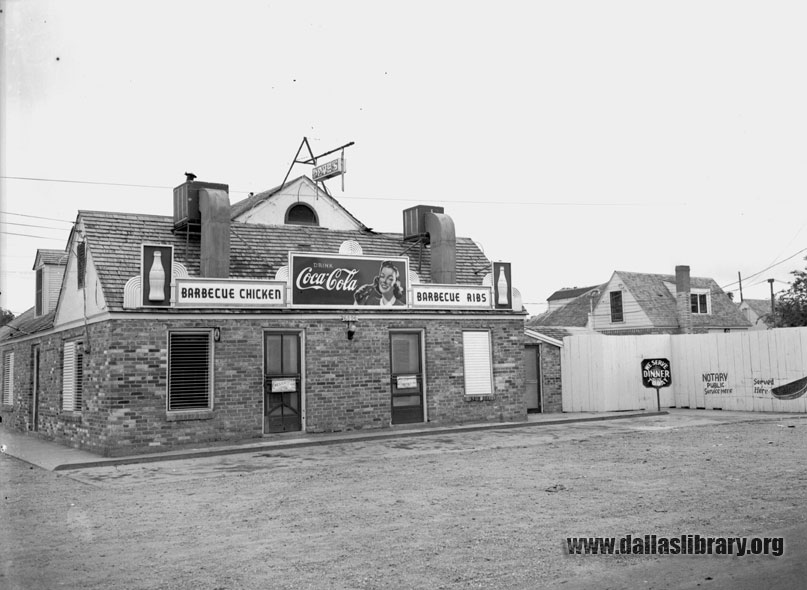
Last summer, Amy Severson, co-owner of Sevy’s, blogger, and all-around smart person, and I had what we thought was a great idea. We decided to write a book on the history of Dallas food. We began collecting bits and pieces of information and interviewed grandchildren of long-lost Dallas restaurants and food businesses. What we have found is unique and amazing and over the next few months, we will post some of the discoveries .In Part 1, we wrote about La Tunisia. Part 2 profiled Mrs. Ida Chitwood . Today we present the Legend of Eltee O. Dave.
We all know the story of Dallas barbecue giant Sonny Bryan, but very little has been written about Dallas’ successful pitmaster Eltee O. Dave. When the 12-year Dave rode his bike from Grimes County (between College Station and Houston) to Dallas in 1915, he had no idea he would become a successful African American in the 1940s. Many old-timers consider him to be Dallas’ first home-grown African American millionaire.
Jump.Dave probably would have called his success hard work, because it never came easily to him. He spent many years working as a chauffeur and handyman for A. C. Ebie, a powerful Dallas businessman and General Manager of Magnolia Petroleum Company. Dave saved the money he made and used his earnings to purchase a 204-acre farm in Carrollton in the 1930s. When Mr. Ebie died in 1938, he left Dave and his wife Betty $1,000. In 1940, they used the money to purchase several properties in the Elm Thicket neighborhood of Dallas, was located on the eastern edge of Love Airfield, a single runway at the time.
Elm Thicket was a tough area that ran from south from Mockingbird to Northwest Highway. During the late 20s, it was a shanty town known for its stills and bootleggers during prohibition. Most of the houses didn’t have indoor plumbing and electricity and well water caused many outbreaks of typhoid in 1934. By the early 1940s Elm Thicket had morphed into a mixed race, working class combination of houses, shacks, and Quonset huts. On one of his properties, Dave built Dave’s Barbecue, a restaurant that served “blacks only.” As the popularity of his meats grew he served take-out to the white workers who were expanding Love Field to accommodate the growth from WWII and the increase in commercial airline traffic. At the same time, Highland Park was swelling to the east and the current Bluffview neighborhood was also pushing the black residents out of Elm Thicket. But Eltee Dave didn’t budge. Instead he smartly expanded the restaurant by adding a “whites only” dining room.
“As a boy I would take a little green bowl to the back door of the barbecue joint and pass it through to Dave so that he could put $2 worth of meat in the bowl,” Jesse Graves, a former resident of Elm Thicket remembers. “It was the best barbecue that I have ever eaten.” By this time, Dave had expanded his business to include several rent houses, a motel, a service station, and a wood yard where residents bought wood to cook with. Dave was the largest land owner in the area.
Which became a huge problem for the city of Dallas when they decided to expand Love Field and move Lemmon Avenue to the east. Dave was given two choices: sell, or face condemnation. In 1955, he settled on a payment of $125,525 for all of his properties and businesses.
The exact details of what Dave did over the next twenty years are sketchy. However, we know he built at least four barbecue restaurants, all named Dave’s Place. Dave worked in the kitchen of his Westmoreland location. He “rented out” the other three, an early and inexpensive version of franchising.
A 1975 D Magazine ran a review of Dave’s noted, “He putters around his bricked smoke-pit room in a white chefs uniform (complete with tall rumpled chef’s hat) as surely and dapperly as if he were manning the soufflés at the Pyramid Room.” By this time, Dave also owned three ranches, one of which was a 192-acre cattle farm at the edge of Lou Foote airfield in Grand Prairie. By 1965 the land was encircled by housing developments. The tag of “Dallas’ first black millionaire” was attached to his name.
Eltee Dave died doing what he loved. He did not have to work, but on November 14, 1976 he was in the kitchen of the restaurant when he heard commotion in the front dining room. He walked out to investigate was shot in the head by a suspected heroin addict. The thief took $30 from the cash register but missed the $1,200 in Dave’s pocket. The killer was eventually caught and sent to prison but the damage was done. All of Dave’s restaurants disappeared. (The Dave’s BBQ in South Dallas today is not related to Eltee Dave).
What happened to his holdings and his money? We haven’t found a clear answer. We contacted his granddaughter Alexandria Dave, who was an infant when he was killed, and she didn’t have any details. But we’re still looking.
[Pictures of the original and expanded restaurant exist in the Dallas library archives.]






